| Columns Retired Columns & Blogs |
The Technologically Impressive LCD-4 Planar Magnetic Headphone Manufacturers Comments
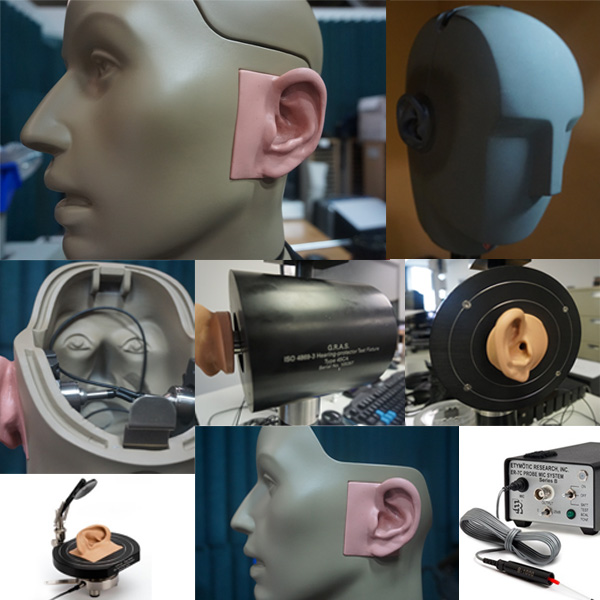
Editor's note: After my review of the LCD-4, Audeze emailed me concerning discrepancies between my measurements and theirs. Numerous fairly technical emails were exchanged, I sent a number of Excel spreadsheets of my measurements for their use in comparisons, and there certainly does seem to be a discrepancy between measurements.
The folks at Audeze asked if they could write an article about these measurement observations and their response to my LCD-4 review. I said, "Of course, I've got plenty to learn on this subject." This article is Audeze's response.
How much do you trust measurements to determine how a headphone will sound? What if measurements from different systems vary significantly, which set of measurement would you use to judge how a headphone will sound?
Headphone measurements are tricky. Interpreting them and relating to what you would likely hear is a bigger problem.
Before we get into the recently published review and measurements on the LCD-4, let's begin with an example. Here's a comparison of the EL-8 measured on Tyll's setup and a calibrated GRAS 43AG ear and cheek simulator at Audeze. As you can see, Tyll's measurements shows a significant drop between 5 and 8 kHz, but you don't see it in the GRAS 43AG. How will you know which of the two measurements reflect what you will hear?
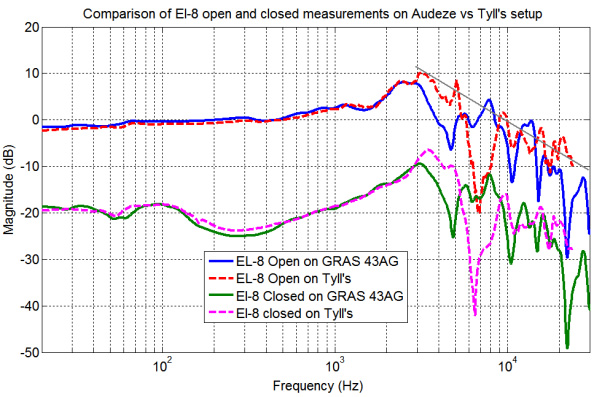
The differences we see in measurements -- not just on Tyll's system but across multiple systems -- are due to many factors, including how the inner ear is modeled, the differences in pinna and concha geometry, and how the headphone and earpad interact with the pinna. Adding to the confusion are measurements published by different users.
Measurements of the same headphone on multiple systems yield significant, if not dramatic, variations in the plotted frequency response, especially above 2kHz. It's not easy to interpolate and go from one system to another, let alone interpret them.
Measurements are useful if their limitations are understood and they do play a key role in our design process.
Audeze Design Philosophy
Audeze designs its headphones to sound as natural and as close to the original performance as possible. We always strive to accurately reproduce instruments and vocals, each in their own space. Our goal is to make them sound like a good pair of speakers in a well treated room.
We accomplish these goals by evaluating our headphones in a number of ways:
- Our engineers have their own set of measurements made with probe microphones near the eardrum and we measure the response of our headphones and our reference stereo speakers. Then we measure using dummy heads and ear simulators. Over time we've accumulated tens of thousands of these measurements in our database.
- We compare test tracks played through our headphones to those played through a pair of reference stereo speakers in a well-treated room.
- We conducted dozens of live recording sessions with a grammy award winning recording engineer and recorded vocals and instruments in controlled environments including position of the artists, microphone orientation, etc. We listen carefully to how our headphones reproduce the music. We're proud of the accurate imaging and natural tonal balance of our headphones.
- We have developed DSP tools that allow us to modify the frequency response and impulse response of our headphones without introducing artifacts and without the need to physically modify our headphones. These tools help us evaluate how changes and tweaks to the headphone's response affect what we ultimately hear.
- We use several sound engineers to beta test them in studios.
LCD-4 Measurements
The LCD-4 is the results of years of research and development to ensure the most natural and transparent sound possible. That's why it was a shock to read Tyll's LCD-4 review. We respect Tyll's subjective opinions about the sound and we'll leave it at that. But the measurements published on Innerfidelity and their interpretation contradicts our own.
After Tyll's comments on the measurements, we reviewed everything objectively; the summary of our findings and our view of the measurements are provided below. We also measured the LCD-4 at a third-party facility and shared this information with Tyll.
The Issue
Here's what Tyll's article said about the frequency response of the LCD-4 he reviewed:
(Quote: A) "Most all LCD headphones I've measured in the past have a distinct drop in treble response starting at 4kHz and going up to about 8kHz."
(Quote: B) "You can see that the LCD-4 is essentially flat from 4kHz to 20kHz when it should be a falling response."
We simply do not see this in any of our measurements. And we do not see this in the audio quality descriptions we get from the vast majority of LCD-4 owners.
More measurements, Checking and Double-Checking.
We measured the LCD-4 on:
a. Artificial head: GRAS KEMAR RA0045 Ear Simulator, KB0066 and KB0065 Pinnae in IEC 60318-4 (previously 60711) configuration.
b. Ear and Cheek Simulator: GRAS 43AG in IEC 60318-4 configuration.
c. Headphone test fixture: GRAS 45CA, KB0071 pinnae, IEC 60711 Ear Simulator. (This setup is similar to the one used in in this paper on Listener Preferences for Different Headphone Target Response Curves by Sean Olive et al. We also used a Sennheiser HD800 as a control to verify that they measured similarly in this setup to those shown in Seal Olive et al paper.
d. Off-site by a third party: To validate our measurements, we had the headphones measured at a 3rd party facility, THX. Their measurements were done using 45CA, the ear simulator was a 43BB IEC 60318-4, (low-noise version using a large pinna).
e. In ear probes on real people: Etymotic Research ER-7C Probe Mic System, series B and customized plugged ear probes.
Comparative Measurements
An average of 10 measurements were used and a 12th-octave smoothing was applied. All measurements are raw and no compensation curve was applied. Measurements were at DRP (Drum Reference Point).
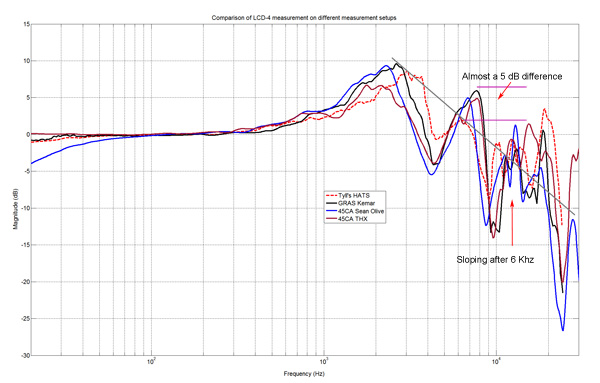
Graph of LCD-4 on various setups at Audeze vs Tyll's HATS
As you can see from the different graphs, there is significant variation in measurements after 2kHz. You can also see around 6kHz, there is almost a 5dB difference. After 6kHz, you can see the response slanting downwards.
The characteristic dip between in the 4kHz-5kHz region is due to the earpad shape and prevents our LCD series from appearing bright.
Below we have plotted a graph of LCD-4 vs HD 800 on a GRAS 45CA (control measurement). We did this to make sure our measurement setup yielded similar results to what was published in the paper by Sean Olive et al.
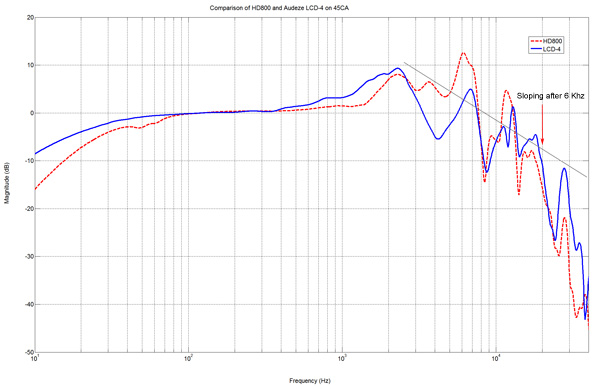
As another comparison, we have measured LCD-4 using in-ear probes at DRP and also measured HD800 at DRP (as control, red dotted line) and we have plotted the average of 5 measurements each made on the left ear. Note that we have included only the range 250Hz to 10kHz as per the probe specification.
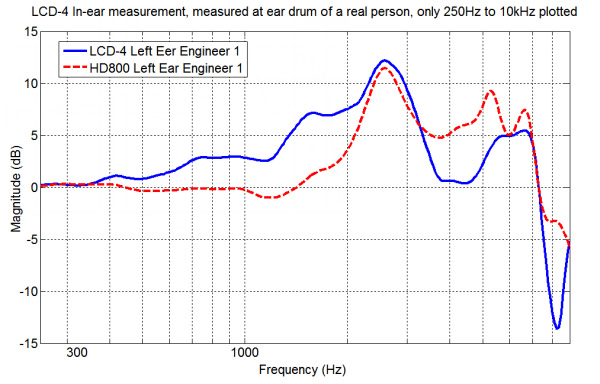
Sometimes removing the ear canal resonance gives a different perspective on the measurements. Below we have plotted the in-ear measurements we made at the ear canal entrance of one of our engineers for the LCD-4 and another planar headphone. Compared to the other headphone we do not see significant deficiencies in the treble region here either.
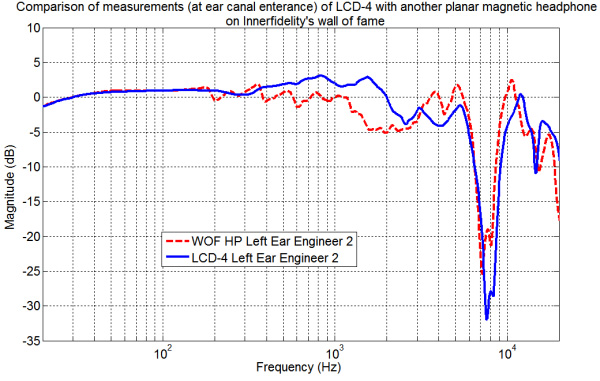
The Audeze Sound
- Unparalleled low-frequency extension due to our large planar drivers and the good seal established by our headband and earpads.
- Smooth through the midrange due to excellent control we have on our diaphragm.
- Close to ideal mid and upper-treble extension starting at 6kHz, slanting downwards from there to 40kHz.
The LCD-4 fits the above sound signature. As we mentioned earlier, our goal is to design headphones that emulate a good sounding speaker in a well treated room. For this reason we've not included any diffused field or free field compensation curves and have stuck with averaged raw responses in this article.
Conclusion
Measurements across multiple systems are significantly different due to the differences in the pinna, concha geometry, inner ear model and how the earpads and headphone interact.
Measurements are valuable tools to get a rough idea of how a headphone may sound, but they are not a substitute for listening. We see significant differences in measurements made on similar systems and also in our in-ear measurements (especially in the treble region). We encourage Innerfidelity readers to audition the headphones for the best possible results.
Thank You
Audeze thanks Tyll and Innerfidelity for being gracious enough to allow us to post this response and share our thoughts with you. We have offered Tyll access to all our measurement systems, labs and resources if he choses to visit Audeze and compare his measurement system to ours. Our goal is encourage more conversation around this topic and contribute back to the community.
Editor's Note: This subject is of great concern to me. My recent survey with a series of polls was intended to get a coarse read on InnerFidelity reader's ability to utilize plots. My take on the polls and reader comments is that the measurements from my system does provide utility, which is reassuring.
However, the above article does show that measurements from one system to the next will yield differing results, and that doesn't make me very happy. I've contacted G.R.A.S. and B&K and have requested a short loan of their head and torso simulators to take measurements here with my rig.
I intend to measure about five headphones on each head, and will look for general differences between the heads. I will also look at how the various heads measure the differences between the headphones to see if the interaction between headphones and the head is consistant. I've got a couple of other ideas, but need to make arrangements before I can tell you about them.
I will continue to use my measurement head for headphone measurements—switching to another head would invalidate comparisons to previous measurements, and....well...I don't have a spare $25,000 to pop for a new one. But it's possible experience with other heads may lead to valuable observations for future compensation curves.
I continue to feel the LCD-4 is too elevated in the top octave and stand by the subjective opinion expressed in my review, but I am deeply thankful to Audeze for taking the time to write their opinion and comparative measurement results. It will lead me, and InnerFidelity readers, to an interesting learning opportunity. Thank you.
- Log in or register to post comments




































